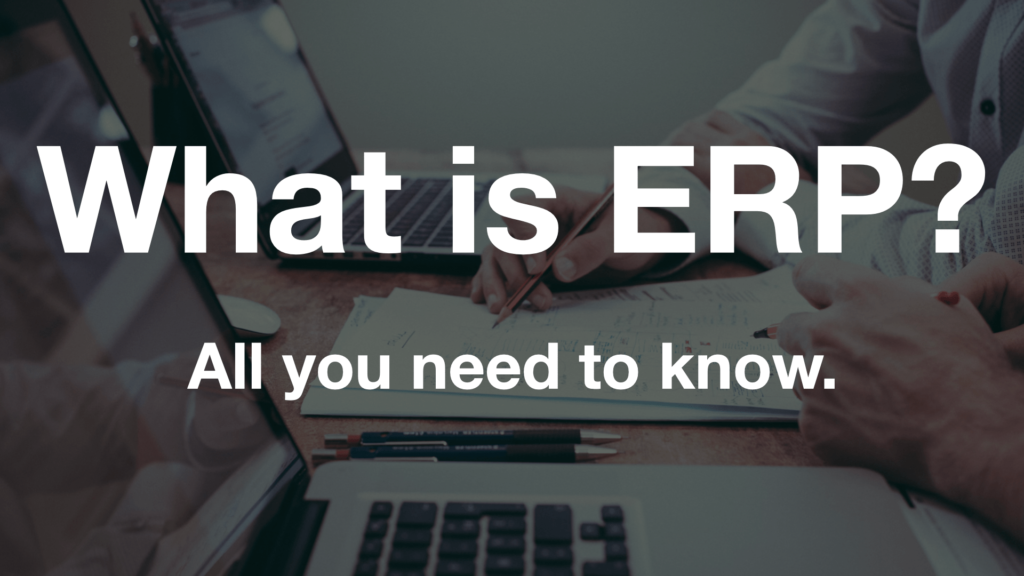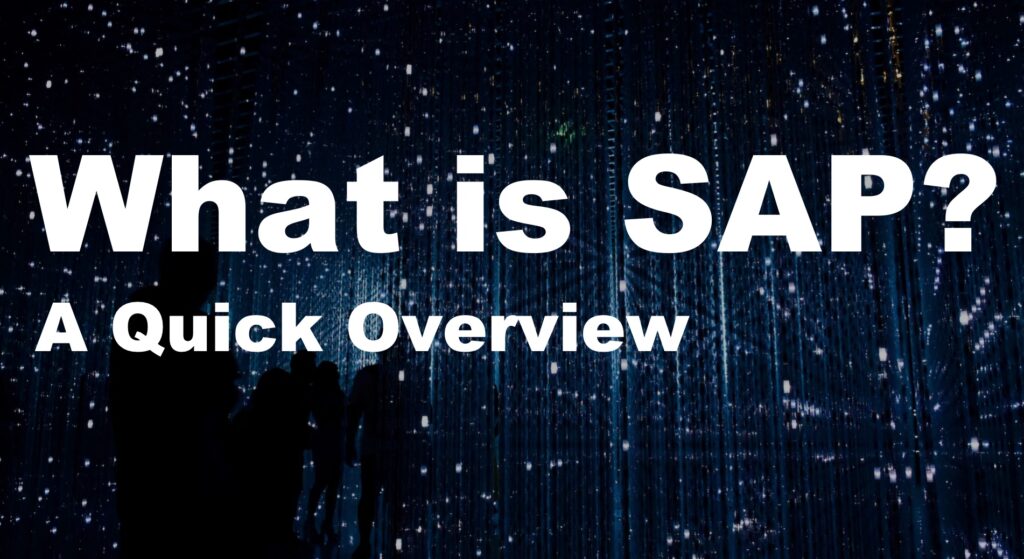Introduction to SAP: A Beginner’s Guide
Demystifying SAP Technologies: Empowering Enterprises for Modern Challenges
Introduction
In the ever-evolving landscape of business and technology, the quest for efficiency, precision, and scalability remains paramount. One name that consistently emerges at the intersection of these needs is SAP (Systems, Applications, and Products in Data Processing). This article delves into SAP technologies, touching upon their importance, core components, and impact on enterprises worldwide.
Please go through our previous blog >> What is SAP? A Quick Overview
What is SAP?
SAP (Systems, Applications, and Products in Data Processing), a German multinational corporation, is a leading global software company that provides enterprise resource planning (ERP) and other business software solutions.
Since its inception in 1972, SAP has been the bedrock of enterprise resource planning (ERP), enabling organizations to integrate disparate business functions into a unified system.
The solutions provided by SAP help organizations manage business processes across various functions such as finance, human resources, supply chain, and customer relationship management. SAP’s most notable products include SAP S/4HANA, SAP ERP, and industry-specific applications, leveraging advanced technologies like in-memory computing, cloud, and real-time analytics to improve efficiency and decision-making.
SAP’s official page talks about ‘What is SAP?’
The Evolution of SAP
Understanding SAP’s evolution is critical to appreciating its current capabilities.
SAP R/2 and R/3: The 1970s to 1990s saw the advent of SAP R/2, a mainframe ERP system. SAP R/3 followed in 1992, marking a transition to client-server architecture, drastically improving flexibility.
SAP ECC (ERP Central Component): Launched in the early 2000s, ECC built upon the robust foundation of R/3, incorporating enhanced functionalities like CRM (Customer Relationship Management) and SRM (Supplier Relationship Management).
SAP S/4HANA: Launched in 2015, SAP S/4HANA represents the latest generation of the SAP Business Suite. It leverages the revolutionary in-memory database technology, SAP HANA, providing unprecedented speed and real-time analytics.
SAP’s official page talks about ‘SAP: A 50-year history of success’
Core Components of SAP S/4HANA
Understanding the core components of SAP S/4HANA is fundamental to grasping its transformative potential:
SAP HANA
SAP HANA (High-Performance Analytic Appliance) is the underlying in-memory database that forms the heart of the S/4HANA suite. Unlike traditional disk-based databases, SAP HANA stores data in-memory, which drastically decreases data retrieval times and enables real-time analytics. This capability allows businesses to run highly transactional and analytical processing on the same platform.
SAP Fiori
SAP Fiori is the user experience (UX) layer that provides a modern, role-based user interface. Designed to improve productivity and user satisfaction, Fiori apps are responsive, intuitive, and accessible across various devices (desktop, tablet, and mobile). It focuses on providing a consistent and simple user experience tailored to different job roles within the organization.
Functional Modules
SAP S/4HANA comprises several functional modules, each tailored to manage different aspects of business operations. Some of the key modules include:
- Finance (FI): This module handles all financial and accounting operations, including general ledger, accounts receivable, accounts payable, and asset accounting. It streamlines financial reporting and ensures compliance with various financial regulations.
- Controlling (CO): Focused on internal reporting, this module supports cost management and internal financial control. It helps in planning, tracking, and optimizing costs and profits across the organization.
- Sales and Distribution (SD): Manage sales transactions, order processing, billing, and invoicing using the SD module. It integrates with other modules to streamline the entire order-to-cash process.
- Materials Management (MM): The MM module oversees procurement, inventory management, and production planning. It ensures efficient sourcing, storage, and tracking of materials required for production and operations.
- Human Capital Management (HCM): This module assists in managing employee-related processes like recruitment, payroll, training, performance evaluation, and workforce planning.
- Production Planning (PP): Streamline production processes, from planning and scheduling to execution and monitoring, ensuring efficient use of resources and alignment with overall business objectives.
- Supply Chain Management (SCM): Optimize the supply chain activities, including demand forecasting, supply network planning, and logistics, ensuring timely delivery and cost efficiency.
Embedded Analytics
SAP S/4HANA comes with embedded analytics capabilities, empowered by the SAP HANA database. These built-in analytical tools allow users to generate real-time reports and insights directly within the transactional environment bypassing the need for data replication to external systems. This enables executives and decision-makers to access up-to-date information and make faster, data-driven decisions.
SAP Business Technology Platform (formerly SAP Cloud Platform)
This platform provides a foundation for developing and integrating customized applications, extensions, and solutions to address specific business challenges. It leverages cloud and on-premise capabilities, enabling seamless integration with other SAP and third-party systems.
SAP S/4HANA Cloud
SAP S/4HANA is available as an on-premise solution and as a SaaS (Software as a Service) cloud offering. The cloud version provides greater flexibility and scalability, ensuring businesses can easily adapt to new requirements and technological advancements without significant infrastructural investments.
Advanced Technologies Integration
SAP S/4HANA integrates advanced technologies like Artificial Intelligence (AI), Machine Learning (ML), Internet of Things (IoT), and blockchain. These technologies enhance the system’s capabilities by enabling predictive analytics, intelligent automation, real-time monitoring, and secure, transparent transactions.
Centralized Master Data Management (MDM)
Effective MDM within SAP S/4HANA ensures that critical business data (such as customer, product, supplier, and financial data) is accurate, consistent, and centrally managed across the enterprise. This minimizes discrepancies and enhances the integrity of business intelligence.
Simplified Data Model
SAP S/4HANA operates on a simplified data model which reduces redundancy and complexity. This structure leads to better performance and easier maintenance, extending S/4HANA’s ability to handle large volumes of data with high efficiency.
Why SAP S/4HANA?
SAP S/4HANA offers real-time data processing and analytics through its in-memory SAP HANA database, allowing businesses to make faster, data-driven decisions. It features a simplified data model and a modern, user-friendly SAP Fiori interface, which improves efficiency and user experience. Additionally, SAP S/4HANA provides greater flexibility with cloud and on-premise deployment options, making it adaptable to various business needs.
The below points explain it further:
- Real-Time Processing: Immediate access to up-to-date data for agile decision-making.
- Simplified Data Model: Reduces complexity and enhances performance.
- Modern User Interface: SAP Fiori provides an intuitive, consistent experience across devices.
- Flexibility: Offers cloud, on-premise, and hybrid deployment options.
- Embedded Analytics: Real-time analytics embedded within business processes.
- Advanced Technologies: Integration with Generative AI, Machine Learning, Robotic Process Automation, and other innovative solutions.
S/4HANA Architecture
SAP S/4HANA is designed to offer a simplified yet powerful architecture that optimizes business processes and facilitates real-time analytics. Understanding the architecture of SAP S/4HANA is crucial for anyone looking to utilize the system to its fullest potential.
Core Layers of S/4HANA Architecture
Database Layer: SAP HANA
At the foundation of S/4HANA is the SAP HANA database, an in-memory, column-oriented, relational database management system (RDBMS). The in-memory capability allows for high-speed data processing and real-time analytics.
Key features of SAP HANA include:
- In-Memory Storage: Data is stored in RAM rather than on traditional disk systems, drastically reducing data retrieval times.
- Column Store: The column-oriented storage format enhances performance, especially for read-heavy analytical queries.
- Data Compression: Advanced data compression techniques reduce the data footprint, making storage more efficient.
- Integrated Analytics: The analytics engine embedded in SAP HANA allows for complex query execution without data replication.
Application Layer
The application layer houses the various business modules of SAP S/4HANA that cater to different business processes. These modules interact with the database layer through the SAP HANA database.
Primary modules include:
- Finance (FI)
- Controlling (CO)
- Sales and Distribution (SD)
- Materials Management (MM)
- Production Planning (PP)
- Human Capital Management (HCM)
- Supply Chain Management (SCM)
The application layer processes transactional data, conducts business logic operations, and interacts with the user interface.
User Interface Layer: SAP Fiori
SAP Fiori provides the front-end user experience for SAP S/4HANA. It offers a role-based, intuitive, and consistent user interface accessible across various devices (desktops, tablets, and smartphones).
- Fiori Launchpad: Acts as the central entry point for users to access applications.
- Role-Based Customization: Tailors the user interface based on user roles and responsibilities.
- Responsive Design: Ensures the interface adapts to different screen sizes and devices seamlessly.
SAP’s official site for S4HANA-related information
Key Architectural Features
The following are the key architectural features of SAP S/4HANA:
Simplified Data Model
SAP S/4HANA features a simplified data model compared to earlier SAP ERP systems. This reduced complexity is achieved by:
- Eliminating Redundancies: Consolidating tables and removing redundant data structures.
- Universal Journal (ACDOCA): Combines multiple financial tables into a single table, streamlining financial and controlling processes.
Embedded Analytics
Real-time embedded analytics are a cornerstone of SAP S/4HANA’s architecture, made possible by the SAP HANA database. These analytics are integrated directly into business processes, enabling:
- Operational Reporting: Real-time reporting capabilities within transactional systems.
- Predictive Analytics: Integrate AI and machine learning models to predict business outcomes.
- Advanced Dashboards: Utilize SAP Fiori for interactive, visual dashboarding.
Integration with SAP Business Technology Platform (BTP)
SAP S/4HANA integrates seamlessly with the SAP Business Technology Platform (BTP, formerly SAP Cloud Platform). This platform provides advanced technologies and services, such as:
- SAP Extension Suite: Enables application development and integration to extend SAP applications.
- SAP Integration Suite: Facilitates seamless integration of SAP and non-SAP applications.
- SAP HANA Cloud: Provides powerful data management and analytics capabilities.
- SAP Data Intelligence: Helps manage and integrate data from various sources.
- SAP Build Process Automation: Automates business processes with ready-to-use packages.
- SAP Cloud ALM: Offers application lifecycle management for cloud environments.
- SAP Datasphere: Enhances data management and analytics with a unified data fabric.
- Generative AI and Machine Learning: Enhancing decision-making with predictive capabilities.
Deployment Options
SAP S/4HANA offers flexible deployment options to fit various business needs:
- On-Premise: Deployed within the organization’s own IT infrastructure.
- Cloud: Available as Software as a Service (SaaS), offering scalability and reduced infrastructure costs.
- Hybrid: A combination of both on-premise and cloud deployments, for a tailored approach.
Implementation Challenges and Tips
Successfully implementing SAP S/4HANA entails navigating various challenges:
Data Migration: Transitioning from legacy systems to S/4HANA requires meticulous data migration strategies to ensure data integrity and minimal downtime.
Customization vs. Standardization: Balancing between customization to fit unique business needs and adopting standard processes is crucial. Over-customization can lead to complex upgrades in the future.
Change Management: Transitioning to S/4HANA often involves a cultural shift within the organization. Effective change management practices are essential to ensure user adoption and minimize resistance.
Skilled Resources: Leveraging skilled consultants and internal resources proficient in S/4HANA can mitigate risks and streamline the implementation process.
Continuous Learning and Support: Post-implementation, continuous learning and support are vital to adapt to new features, updates, and evolving business needs.
Conclusion
SAP Technologies, and specifically SAP S/4HANA, offer unparalleled efficiencies, real-time insights, and a robust platform to navigate the complexities of modern enterprise operations. While the road to implementation may be fraught with challenges, the rewards in terms of agility, cost savings, and future-readiness are undeniable. As businesses gear up for the future, SAP S/4HANA stands as a beacon of innovation and resilience, empowering organizations to thrive amidst evolving technological paradigms.
Important Links
Here are some important links for an SAP Consultant.
SAP Community: https://community.sap.com/
A platform to connect with other SAP professionals, share knowledge, and get answers to your questions.
SAP Learning Hub: https://learninghub.sap.com/
Offers a wide range of learning resources and training materials for SAP solutions.
SAP Support Portal: https://support.sap.com/
Provides access to SAP support services, including software downloads, incident management, and knowledge base articles.
SAP Fiori Design Guidelines: https://experience.sap.com/fiori-design/
Detailed guidelines for designing SAP Fiori apps, ensuring a consistent user experience.
SAP Road Maps: https://www.sap.com/products/roadmaps.html
Information on the latest innovations and future developments in SAP solutions.
SAP Best Practices Explorer: https://rapid.sap.com/bp/
Access to pre-configured business processes and implementation guides.
SAP Activate Methodology: https://www.sap.com/services/implementations/activate.html
A framework for implementing SAP solutions, including best practices, tools, and accelerators.
SAP PartnerEdge: https://partneredge.sap.com/
Resources and support for SAP partners, including training, certification, and marketing tools.
SAP Help Portal: https://help.sap.com/
Comprehensive documentation and guides for all SAP products and solutions.
SAP Developer Center: https://developers.sap.com/
Resources for developers, including APIs, SDKs, and development tools.
SAP Training and Certification Shop: https://training.sap.com/
Offers training courses and certification programs for SAP professionals.
SAP Customer Influence: https://influence.sap.com/
A platform for customers to provide feedback and influence SAP product development.
SAP Innovation Discovery: https://www.sap.com/products/innovation-discovery.html
Helps you discover new innovations and enhancements in SAP products.
SAP Cloud Appliance Library: https://cal.sap.com/
Provides pre-configured SAP solutions in the cloud for quick deployment and testing.
SAP Enterprise Support Academy: https://support.sap.com/en/offerings-programs/enterprise-support/academy.html
Offers expert-guided sessions, best practices, and learning resources for SAP Enterprise Support customers.



